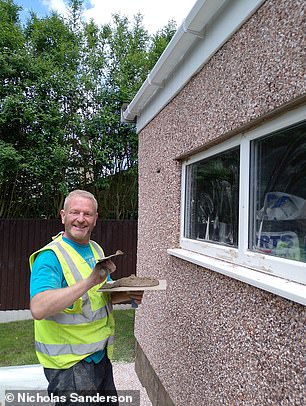Our house is covered with brown pebbles. Should we get rid of that?
We recently moved to a semi-detached house from the 1930s with three bedrooms. It’s spacious inside and we love the area.
Unlike some of the properties we have viewed, the house has been modernized internally to a high standard.
The exterior of the building is pebble, which I believe is a sandy brown color. Our neighbors and quite a few others down the street have the same pebble on their properties.
Our new neighbors hinted that they would prefer if we kept the pebble.
Time to abolish the pebbeldash? A MailOnline reader considers the exterior of their property
But since our house is ultra-modern on the inside, I’m wondering if we should have the pebble removed. I noticed a small number of properties in the area that now have a smooth white exterior.
What are our options for dealing with the Pebbledash? Is removing Pebbledash ever something homeowners can do themselves, or is it too risky?
If we had a professional remove the pebble, how much would it cost? Would a building permit be required?
Or can we just render over the top of the pebble to create a new, smooth, white finish? How would this work and how much would it cost? How sustainable is this option?
Jane Denton replies: Pebbledash’s popularity grew during the post-war years and increased in the 1920s.
It was often used as a cheap option to hide poor masonry or workmanship and protect homes from the elements.
It’s much maligned and falling out of fashion, but maybe we shouldn’t be so hasty.
Although few will admit it, it would be a shame to no longer see these sturdy, spiky, weathered exteriors in the places where they are most effective, namely coastal and rural areas.
As your question suggests, it seems to be a growing trend to cover existing brickwork or pebblework with a smooth white plaster.
However, this comes at a cost and it is important to consider how long this glossy white finish will last before it needs to be reapplied.
As a side note, it may be worth speaking to a local real estate agent to get their thoughts on exterior choices and their impact on property values in the area.
We spoke to a pebbeldash and rendering expert. If you’re looking for a completely unbiased response, look away now.
Nicholas Sanderson, owner of The Pebble Dasher in Lancashire, says: Pebbledash is made using a traditional sand and cement mix and usually contains gravel or stones.
Many people say it looks old and dated. Of course it does. Most of it is about 100 years old, so it’s no surprise that it can look worn and dirty.
It is waterproof, making it incredibly strong and resilient to attack. It is notoriously difficult to remove.
Anyone reading this who has had the misfortune to uninstall Pebbledash knows what I’m talking about: it’s some damn heavy stuff.

Pebbledash attorney Nicholas Sanderson
It is possible to remove Pebbledash yourself, but this is a difficult job and requires good machinery. If you want to avoid damage to your property, it is advisable to ask an experienced builder for help.
Before you make a decision, bear in mind that modern pebble stone contains specialist crushed aggregates and looks just as good as flat plaster when new.
If you go the route of covering the Pebbledash with white rendering, it could cost you 50 percent more than just updating or fixing the Pebbledash.
Plus, in my experience, and some may disagree, you’d be lucky if all these modern renders look good after five years.
I can’t count how many properties I’ve converted to Pebbledash just a few years after the owner had the flat renovated.
Even when applied correctly, the patch is, in my opinion, prone to discoloration. It can look very tired after five years and even worse after ten years.
Many of my clients complain that they have to paint the render repeatedly to keep it looking good.
Whatever you decide to do, in most cases you will not need planning permission to renovate your home, including a color change. However, there are exceptions to this and it is always worth checking with your local council’s planning department in advance.
The amount it would cost you to have the shingle removed is variable and depends on things like where you live and exactly how large your property is. It would cost around £2,000 to have it removed.
To get a smooth white render finish the cost is again variable but I would say this could cost you around £8,000.
Pebbledash has a bad reputation, but I’ve been in the business for 35 years and can tell you it’s not going away. I tell all my students that it is a job for life. There are not many callings where that is the case.

